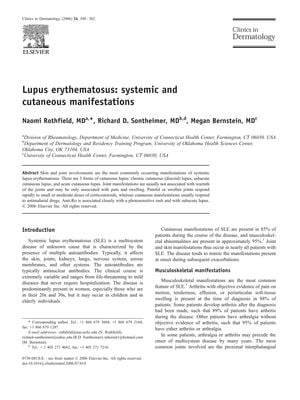Lupus Erythematosus: Systemic and Cutaneous Manifestations
September 2006
in “
Clinics in Dermatology
”
systemic lupus erythematosus SLE cutaneous lupus discoid lupus subacute cutaneous lupus SCLE acute cutaneous lupus corticosteroids antimalarial drugs anti-Ro/SS-A antibodies photosensitivity systemic glucocorticoids hydroxychloroquine biologic treatments thalidomide TNF-α inhibitors lupus steroids antimalarials Plaquenil biologics TNF inhibitors

TLDR Lupus affects the body and skin, causing joint pain and skin issues that can be treated with steroids and antimalarial drugs.
The 2006 document provides a detailed examination of lupus erythematosus, particularly focusing on systemic lupus erythematosus (SLE) and its cutaneous manifestations, which include chronic cutaneous (discoid) lupus, subacute cutaneous lupus (SCLE), and acute cutaneous lupus. It explains that joint symptoms in SLE typically present with pain and swelling without warmth and respond well to corticosteroids, while skin manifestations often respond to antimalarial drugs. The document also discusses the pathophysiology, genetic factors, and autoimmune mechanisms of lupus skin disease, as well as the clinical characteristics and classification of cutaneous manifestations. It notes that anti-Ro/SS-A antibodies are associated with photosensitivity in 90% of SCLE cases and that certain drugs can induce SCLE. Treatment options for SLE include systemic glucocorticoids, antimalarials, and experimental therapies, while cutaneous manifestations are managed with sun protection, topical treatments, and systemic treatments like hydroxychloroquine. The document also explores the potential of biologic treatments for CLE, such as thalidomide and TNF-α inhibitors, despite the risk of drug-induced CLE from these biologics. However, the document does not provide specific numbers of people involved in the studies or anecdotal reports mentioned.



